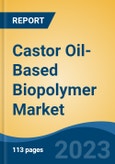Speak directly to the analyst to clarify any post sales queries you may have.
10% Free customizationThis report comes with 10% free customization, enabling you to add data that meets your specific business needs.
The market is positioned for strong mid- to long-term growth, driven by tightening global sustainability regulations, corporate ESG mandates, and material substitution initiatives across value chains. However, expansion is currently tempered by structural challenges such as higher production and processing costs versus conventional polymers, raw material supply constraints concentrated in limited geographies, and insufficient downstream awareness or adoption readiness, particularly among mid-market manufacturers.
Despite these barriers, the trajectory remains upward. Market participants are investing in specialized R&D, regional production footprints, and application-specific innovations to unlock scale and competitiveness. As demand continues to shift from commodity to purpose-built, bio-based materials with measurable performance advantages, castor oil-based biopolymers are well-positioned to transition from specialty use cases to mainstream adoption in engineered product applications.
Key Market Drivers
Rising Demand for Sustainable and Bio-Based Materials
The rising demand for sustainable and bio-based materials is a key driver accelerating the growth of the Global Castor Oil-Based Biopolymer Market, as industries and consumers alike shift toward more environmentally responsible alternatives to traditional fossil-based plastics. As the impacts of climate change, plastic pollution, and resource depletion become more pronounced, governments, corporations, and consumers are embracing sustainability as a strategic imperative. This has created strong market momentum for renewable, non-toxic, and biodegradable materials. Castor oil-based biopolymers, derived from a non-edible and renewable crop, are increasingly viewed as a viable alternative to conventional polymers, aligning well with the principles of green chemistry and circular economy models.Traditional plastics, made from petroleum derivatives, contribute heavily to environmental degradation and greenhouse gas emissions. As a result, manufacturers across industries are actively seeking bio-based substitutes that offer similar or improved performance without the environmental burden. Castor oil-based biopolymers offer a low-carbon footprint, are derived from non-GMO, non-food crops, and can match the functionality of synthetic polymers in a range of applications from automotive parts to consumer electronics. Multinational companies are increasingly integrating Environmental, Social, and Governance (ESG) goals into their business models, driving demand for eco-friendly materials.
Brands in sectors such as automotive, fashion, electronics, and personal care are turning to castor oil-based polymers to meet internal sustainability targets, reduce Scope 3 emissions, and cater to eco-conscious customers. Products marketed as “bio-based” or “plant-derived” are gaining strong consumer traction, enhancing brand value and customer loyalty. Public and private sector buyers are prioritizing materials that comply with green procurement standards and sustainability certifications. Castor oil-based biopolymers often qualify under programs such as USDA BioPreferred, REACH-compliant material lists, RoHS and ISO 14001 environmental standards. These certifications open doors to environmentally sensitive markets and allow manufacturers to access green labeling and procurement incentives.
Key Market Challenges
High Production Costs Compared to Conventional Polymers
One of the primary challenges restricting the growth of castor oil-based biopolymers is their relatively high production cost. Several factors contribute to this Specialized processing technologies and low economies of scale lead to higher manufacturing costs. Complex conversion processes from castor oil to bio-polyamides or bio-polyurethanes require significant energy and specialized catalysts. The initial capital investment for bio-polymer production facilities is substantially higher compared to traditional plastic plants. As a result, end-users especially in cost-sensitive sectors like packaging and consumer goods may opt for cheaper, petroleum-based alternatives unless offset by regulatory incentives or long-term sustainability goals. This cost competitiveness gap remains a significant hurdle in achieving widespread adoption.Key Market Trends
Integration into Circular Economy Models
A growing number of industries are moving beyond just “eco-friendly” materials to embrace closed-loop, circular economy models, where materials are renewable, recyclable, and reusable across product lifecycles. Castor oil-based biopolymers fit this model exceptionally well due to their Renewable, non-edible agricultural origin, Potential for recyclability and biodegradability, Minimal impact on food supply chains.Forward-thinking manufacturers are now designing products for disassembly and reuse, with castor-based polymers as part of their sustainable materials portfolio. This positions castor oil-derived biopolymers as enablers of next-generation product stewardship programs and low-waste manufacturing strategies especially in sectors like automotive, electronics, and apparel. As circular economy frameworks become more mainstream, the demand for materials that align with these systems is expected to surge.
Key Market Players
- Arkema
- BASF SE
- Evonik Industries AG
- Solvay
- TORAY INDUSTRIES, INC.
- DuPont de Nemours, Inc.
- Mitsui Chemicals, Inc.
- Lanxess
- Asahi Kasei Corporation
- Nexis Fibers A.S.
Report Scope:
In this report, the Global Castor Oil-Based Biopolymer Market has been segmented into the following categories, in addition to the industry trends which have also been detailed below:Castor Oil-Based Biopolymer Market, By Type:
- Bio-Polyamide
- Bio-Polyurethane
- Oleochemicals & Derivatives
Castor Oil-Based Biopolymer Market, By End Use:
- Automotive
- Electronics
- Textile
- Packaging
- Others
Castor Oil-Based Biopolymer Market, By Region:
- North America
- United States
- Canada
- Mexico
- Europe
- France
- United Kingdom
- Italy
- Germany
- Spain
- Asia-Pacific
- China
- India
- Japan
- Australia
- South Korea
- South America
- Brazil
- Argentina
- Colombia
- Middle East & Africa
- South Africa
- Saudi Arabia
- UAE
Competitive Landscape
Company Profiles: Detailed analysis of the major companies present in the Global Castor Oil-Based Biopolymer Market.Available Customizations:
With the given market data, the publisher offers customizations according to a company's specific needs. The following customization options are available for the report.Company Information
- Detailed analysis and profiling of additional market players (up to five).
Table of Contents
Companies Mentioned
- Arkema
- BASF SE
- Evonik Industries AG
- Solvay
- TORAY INDUSTRIES, INC.
- DuPont de Nemours, Inc.
- Mitsui Chemicals, Inc.
- Lanxess
- Asahi Kasei Corporation
- Nexis Fibers A.S.








